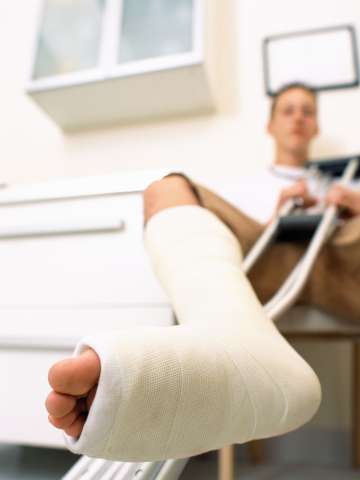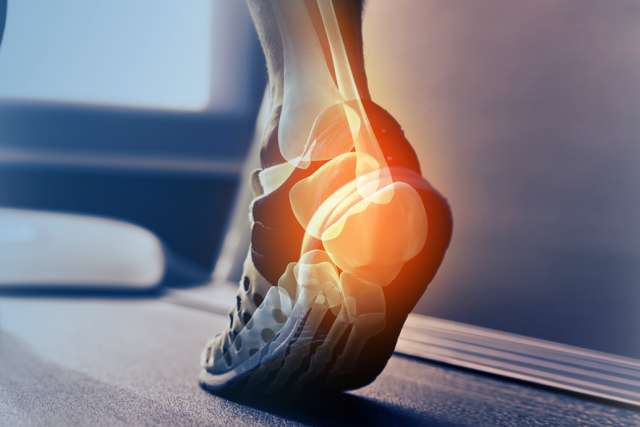Foot and Ankle Surgery
High surgery volumes mean our foot and ankle surgeons are among the most experienced in the region. We specialize in total ankle replacement and revision surgeries.

Why choose UCLA Health for foot and ankle surgery?
The foot and ankle surgeons at UCLA Health offer full-spectrum care for foot and ankle injuries and disorders. We use a wide range of advanced techniques to help patients get back on their feet more quickly with less pain.
Highlights of our program include:
Physician expertise: Our high surgery volumes mean our physicians have robust experience in a spectrum of procedures. We are experts in total ankle arthroplasty and revision procedures, as well as arthroscopy for cartilage repairs.
Advanced techniques: We use state-of-the-art technology to perform advanced operations. For example, we use lapiplasty for bunion surgery. This tool corrects bunion deformities with consistently better results, and patients benefit from early weightbearing and mobilization.
Pain management: With the help of our anesthesiology team, we offer patients pain management tools that reduce postoperative pain without the need for opioids. Our foot and ankle surgeons perform outpatient procedures with regional pain blocks, helping patients return home and recover more quickly.
Research emphasis: Our specialists are heavily involved in clinical trials and research. We constantly update treatment protocols to match leading-edge protocols.
Conditions foot and ankle surgeons treat
We treat a variety of injuries and disorders affecting the foot and ankle, including:
Achilles tendon injuries: Partial or complete rupture (strain) of the tendon at the back of the heel (Achilles tendon), often resulting from overuse or repetitive stress
Ankle instability: A recurrent feeling of “giving way” on the outer side of the ankle, often developing after repeat ankle sprains
Bunions: Bony bumps that form on the joint at the base of the big toe
Cartilage injuries: Any damage to the cartilage, the spongy tissue that covers, cushions and acts as a shock absorber at the ends of bones
Claw toe: A toe that is bent into a claw-like shape, often caused by improperly fitting shoes or nerve damage in the foot
Foot and ankle arthritis: Inflammation in the foot and ankle joints, often caused by breakdown of the cartilage that cushions bones, as in osteoarthritis
Foot and ankle deformities: Conditions that change the usual shape of the foot and can either be present at birth or develop over time as the result of trauma, ill-fitting footwear or improper foot mechanics
Foot and ankle fractures: Breaks in one or more bones of the foot or ankle, often resulting from a fall or direct trauma
Hammer toe: An abnormal bend in the middle joint of a toe, often affecting the second, third or fourth toes
Morton’s neuroma: Thickened tissue near the nerves leading to the toes, often causing sharp pain or numbness in the ball of the foot
Tendon injuries: Any damage to the tendons, the bands of tissue that connect muscles to bones
Foot and ankle surgeries we offer
Our surgeons offer both minimally invasive and open procedures, personalizing surgical plans to each patient’s needs. We specialize in total ankle replacements and revision surgeries for patients with previously failed ankle implants.
Foot and ankle surgeries we offer include:
Arthroscopy: The surgeon makes a small incision near the ankle joint, then inserts a video camera through the incision. This allows us to view the inside of the joint and possibly repair joint damage without the need for a large incision. We may use arthroscopy to treat cartilage or tendon injuries.
Cartilage repair: In these procedures, the surgeon may remove loose cartilage or stimulate the growth of new cartilage. Examples of cartilage repair procedures include osteochondral allograft or autograft transplantation, in which the surgeon replaces damaged cartilage and bone with tissue from a donor or from elsewhere in your body.
Fracture care and repair: Fracture treatment may include using screws, plates or metal rods to repair and hold a fractured bone in place as it heals. Surgeons usually use these techniques for complex or severe ankle fractures. We often perform open reduction and internal fixation (ORIF) surgery to put broken bones back together and hold them in place with metal plates or screws during healing.
Joint fusion (arthrodesis): This operation joins two or more bones to increase stability. The surgeon may also remove damaged or diseased cartilage during a joint fusion. Patients with severe ankle arthritis may benefit from joint fusion.
Joint reconstruction: These procedures aim to repair damaged joints. Surgeries can range from treating minor joint repair, such as in arthroscopy, to a total ankle replacement. Joint replacement is often a treatment for patients with severe arthritis.
Ligament repair and reconstruction: These surgeries restore or replace torn or damaged ligaments, the strong bands of tissue connecting bone to bone. The surgeon may use arthroscopy to repair ligaments. Or they may perform lateral ankle ligament reconstruction, in which they tighten ligaments by shortening and reattaching them to your ankle bone. Ligament repair may be needed for high ankle sprains or severe ankle sprains accompanied by other injuries.
Osteotomy: The surgeon cuts a bone to shorten, lengthen or realign it. Patients may have an osteotomy to treat arthritis or a limb length discrepancy (LLD), when the legs are not the same length. An LLD can occur as a birth abnormality or it may be acquired, as when a fractured bone doesn’t heal properly.
Tendon repair and reconstruction: These surgeries restore or replace torn or damaged foot and ankle tendons, including the Achilles tendon. Tendons are the strong bands of tissue connecting muscle to bone. The surgeon may use arthroscopic surgery or other techniques to sew the torn ends of tendons back together. They may also perform a tendon reconstruction, where they take tissue from a donor or elsewhere in your body to reconstruct the tendon.
Total ankle arthroplasty and revisions: Also called an ankle replacement, this procedure removes the damaged portion of the ankle joint and replaces it with prosthetic parts. Our surgeons also perform a high volume of revision total ankle replacements for patients who have had complications from a previous ankle arthroplasty. Total ankle arthroplasty may be an appropriate treatment for patients with arthritis.
Our expert team
Our foot and ankle surgeons are experts in clinical care and research. We are skilled in many advanced surgeries, personalizing care plans to each patient’s needs. Patients who choose us benefit from well-rounded, comprehensive treatment.
Contact us
Call to request an appointment with a foot and ankle surgeon at UCLA Health.
Find your care
Our foot and ankle surgeons are skilled in a wide range of advanced techniques. Call to learn more about foot and ankle surgery at UCLA Health.

